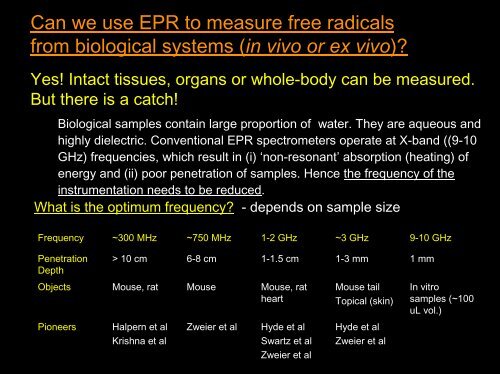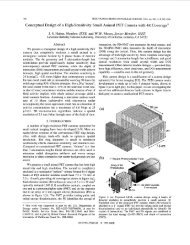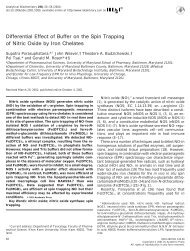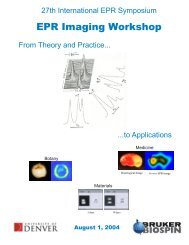EPR Spectroscopy
EPR Spectroscopy
EPR Spectroscopy
Create successful ePaper yourself
Turn your PDF publications into a flip-book with our unique Google optimized e-Paper software.
Can we use <strong>EPR</strong> to measure free radicals<br />
from biological systems (in vivo or ex vivo)?<br />
What do we do with it?<br />
Yes! Intact tissues, organs or whole-body can be measured.<br />
But there is a catch!<br />
Biological samples contain large proportion of water. They are aqueous and<br />
highly dielectric. Conventional <strong>EPR</strong> spectrometers operate at X-band ((9-10<br />
GHz) frequencies, which result in (i) ‘non-resonant’ absorption (heating) of<br />
energy and (ii) poor penetration of samples. Hence the frequency of the<br />
instrumentation needs to be reduced.<br />
What is the optimum frequency? - depends on sample size<br />
Frequency<br />
~300 MHz<br />
~750 MHz<br />
1-2 GHz<br />
~3 GHz<br />
9-10 GHz<br />
Penetration<br />
Depth<br />
> 10 cm<br />
6-8 cm<br />
1-1.5 cm<br />
1-3 mm<br />
1 mm<br />
Objects<br />
Mouse, rat<br />
Mouse<br />
Mouse, rat<br />
heart<br />
Mouse tail<br />
Topical (skin)<br />
In vitro<br />
samples (~100<br />
uL vol.)<br />
Pioneers<br />
Halpern et al<br />
Krishna et al<br />
Zweier et al<br />
Hyde et al<br />
Swartz et al<br />
Zweier et al<br />
Hyde et al<br />
Zweier et al







